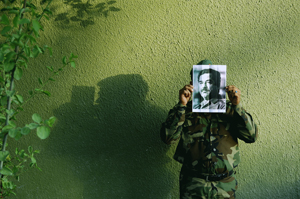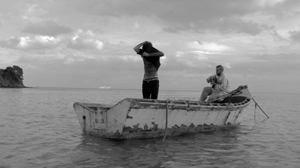The Suffering or the Heat
John Haberin New York City
Theater of Operations and Waiting for Omar Gatlato
Burning oil fills the skies of Kuwait, while a voice can intone only the lamest of comforts about beauty. For Monira Al Qadiri the fires still rage after nearly thirty years, but their "heat becomes lost."
Across the hall at MoMA PS1, Khalifa Qattan finds that his painterly visions of The Deep Wound and Polluted Earth have become "prophetic" but that much harder to grasp. Just within, Karen Finley in no end of text on canvas reminds Americans to assume responsibility and to "get a life." In "Theater of Operations," a local artist's words and images may never encompass the suffering or the heat. In in the wider region, too, the heat is on. Nearly sixty years after its struggle for independence, eighteen years after its civil war, and nearly a decade after the Arab spring, Algeria is still waiting. To trust the Wallach Art Gallery, it is "Waiting for Omar Gatlato." 
Wars on end
Oh, that Gulf War. A college student today could hardly remember Operation Desert Storm in 1990 and 1991 to repel invasion from Saddam Hussein. No more can the youngest Iraqi artists in the show, like Ali Eyal abstracting away from Google Earth or Urok Shirhan in the Netherlands. Few could so long after George W. Bush began his Iraqi war in 2003—destabilizing the region, torturing supposed enemies, and killing or displacing millions on the basis of criminal lies. In their art, though, the earlier war never did end, and one can only wonder if it never, ever will. A glowing painting must remain forever unfinished, because a Clinton administration strike killed Layla Al-Attar, and seemingly nothing since has changed.
For the curators, led by Peter Eleey and Ruba Katrib, nothing could—in an exhausting show spanning every floor of MoMA PS1, much like "September 11" at the museum in 2010. The first rooms stick to the first Gulf War and the final rooms to the second, but chronology breaks down in between. The eighty artists fall in no particular order at that, with no obvious divisions or common themes. Dia al-Azzawi and Rafa Nasiri of the pioneering New Vision Group turn up apart from one another, with several works apiece. It makes choosing winners simply impossible. Fortunately, those stubborn Americans are here to offer instruction.
Is that the same "orientalism" that artists like Karen Finley would rightly decry? Mary Kelly can always trot out pretend medals and Sue Coe graphic violence, while Louise Lawler and the Guerrilla Girls can always locate the problem in museums and the treatment of women. Tony Cokes can always turn his lectures into PowerPoints—and Jenny Holzer, far more perceptively, into crawl screens. Martha Rosler will never lose her biting wit, but she is still recycling her collage assault on consumer culture and the war in Vietnam. A corner pile of licorice from Félix Gonzáles-Torres resembles ammunition, but it is still his candy. When Luc Tuymans in Belgium plays on Condoleezza Rice's African American features to damn her as secretary of state, that does not sound terribly progressive either.
If nothing here ever changes, like the face of Saddam that still disguises portrait photos by Jamal Penjweny, that comes only naturally to Thuraya Al-Baqsami in Kuwait or Nuha al-Radi in Iraq, caught between a more ancient art and the present-day face of war. It can also come intentionally—with a turn to how war is perceived. Michel Auder sees only a "TV war," Richard Hamilton his living room, and Thomas Hirschhorn a touch screen, but then they cannot turn off the screen. Rainer Ganahl recreates screen captures from CNN, Fox News, and The New York Times in paint, while Rachel Khedoori fills seventy thick volumes with every news article she can find, in fine print. For Allan Sekula, the media have made this a "war without bodies." For Harun Farocki, it has become "war at a distance" as well, thanks to "smart bombs."
Yet something has changed, drastically. For one thing, the invader became the United States. For Roger Brown, the first Gulf war boils down to a dollar sign, but for bodies on the ground it could not. With the second Iraqi war, though, some of the same artists register the difference. Reservists in photos by Judith Joy Ross become war protestors a decade later, while al-Azzawi's painted protests have taken on the look of Picasso's Guernica, but with troubling stains of red. That same shift has drawn in such artists as Melvin Edwards, Fernando Botero, and Richard Serra.
For another thing, the first war sent many into exile—so that now they, too, are seeing a war-torn land from outside. Earlier works do include Palestinians like Elia Suleiman in a desolate New York apartment, but no one else trapped between worlds. (And why bring in the Arab-Israeli war at all?) If the very contents of a life have since become portable, that may explain the many artist books. They include accordion books by Mohammed Muhraddin and Ali Rashid, books chained in barbed wire by Ghassan Ghaib, books with gaping holes by Shakir Hassan Al Said and Mohammed Al Shammarey, and a book to hold stones by Nazar Yahya. Maybe virtual reality does not have the last word after all.
Waiting for Islam's Godot
If "Waiting for Omar Gatlato" sounds like an awfully obscure title for an exhibition, it should. Columbia University's art gallery borrows from a forty-year-old text on Algerian film, well before the Arab spring and contemporary African art. That, in turn, refers in its proper name to an older "film classic," as the gallery has it, in a show about anything but film. Yet its two dozen or so contemporary artists are not just watching or waiting. Many are still struggling simply to break out of old narratives and, only at times, succeeding. Mounir Gouri even calls his video Shipwreck.
Already, you must be bracing yourself for a stern recent history lesson, much as when the gallery looked at Harlem art or black women in European painting, and Louisa Babari (with Célio Pailliard), just for starters, supplies one. In a dark, empty alcove that you might be quite happy to overlook, a voice fills you in on Frantz Fanon, "close combat," and "colonial pathology." Sara Sadik appears on screen in vivid colors, but she is just lecturing, too—about beurs, or Europeans of Algerian parents like herself. (Think of Berbers, the country's principal Arab peoples.) And the curator, Natasha Marie Llorens, plainly loves lectures, especially when they still point the finger at France. The Cardinal's Arm by Fayçal Baghriche, a gilded arm grasping a gilded cross, literally points one in a largely Islamic nation.
 France here weighs heavily, so many decades after the fact—and centuries after Eugène Delacroix and his Women of Algiers. Fanon, who wrote the book on colonialism with The Wretched of the Earth in 1961, served in a hospital during the French-Algerian war—a subject for Lydia Ourahmane as well. The show's title also plays on Samuel Becket's Waiting for Godot, while shunning so much as a mention of Becket's fellow absurdist and fellow fighter in the French resistance, Albert Camus. While Camus hated Colonialism, he also hoped against hope for a multicultural society in his native Algeria. (And no, The Stranger is not a defense of the random killing of Arabs.) Yet the artists have divided sympathies as well.
France here weighs heavily, so many decades after the fact—and centuries after Eugène Delacroix and his Women of Algiers. Fanon, who wrote the book on colonialism with The Wretched of the Earth in 1961, served in a hospital during the French-Algerian war—a subject for Lydia Ourahmane as well. The show's title also plays on Samuel Becket's Waiting for Godot, while shunning so much as a mention of Becket's fellow absurdist and fellow fighter in the French resistance, Albert Camus. While Camus hated Colonialism, he also hoped against hope for a multicultural society in his native Algeria. (And no, The Stranger is not a defense of the random killing of Arabs.) Yet the artists have divided sympathies as well.
After the lectures, Sadek Rahim and Lydia Ourahmane may come off as the most dogmatic—the first with Lady Liberty in carpet fibers, the second with chains ending in dog collars on the floor. Still, one is as funny and wistful as the other is sincerely chilling. And the brutalism of concrete for Islamic training camps, in photos by Sofiane Zouggar, is chilling, too. Titles appear throughout in French and English, while Arabic characters appear just twice. Yazid Oulab places them on musical instruments, reconstructed to map unheard sound patterns, while Adel Bentounsi transfers keyboard labels to a pressure cooker. Life here really is a pressure cooker and, contrary to William Butler Yeats, unheard music is not necessarily sweeter.
A European heritage appears as a mixed blessing for Halida Boughriet, who strands his subjects in a Paris museum. It does as well for Mourad Krinah, whose abstract rendering of war draws on the scale and color of Joan Mitchell together with a Renaissance battle scene by Paolo Uccello. It may yet, too, for Dania Reymond, who looks back to a French botanic garden in 1832 as a study in acculturation. Self-rule, though, comes at a price as well. That is not western clothing that binds Sonia Merabet. In an animation, Massinissa Selmani approaches a ruling dictator with an electric fan, as if uncertain whether to serve his needs or to blow him to the winds.
The dominant tone is melancholy, as in the archly dour drawing of a bird by Hakima El Djoudi, as Melancholy of the King. Shipwrecked in a rusted lifeboat, one of Gouri's North African refugees can only strum a sad song while his bare-chested companion attempts to dance. Cheap housing, in wood fragments from Karim Ghelloussi, becomes Memory of the Jungle. People look out over their own country in paintings by Bardi, EL Meya, Fella Tamzali Tahari, and Djamel Tatah, wary or in pain. Tatah's women also pose in front of a Minimalist red backdrop while just one edges toward a painted shoreline, trapped between East and West in geography or in art. Now that, since last April, a long and often dictatorial regime is gone, you will just have to see where they end up.
"Theater of Operations" ran at MoMA PS1 through March 1, 2020, "Waiting for Omar Gatlato" at the Wallach Art Gallery of Columbia University through March 15.




